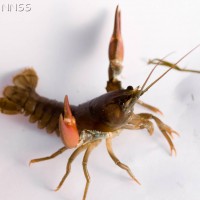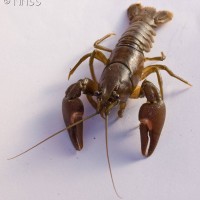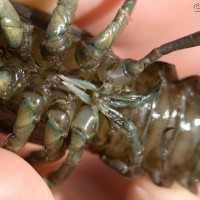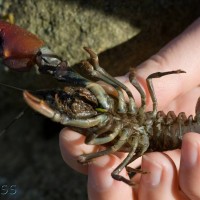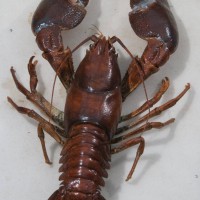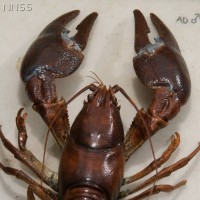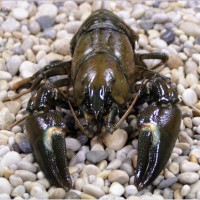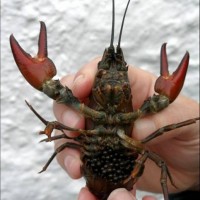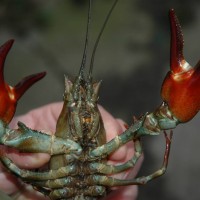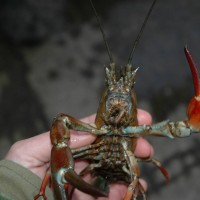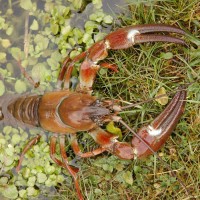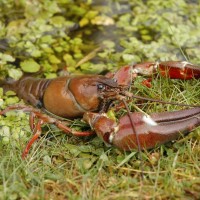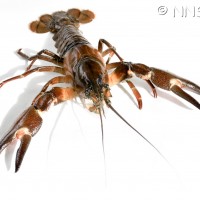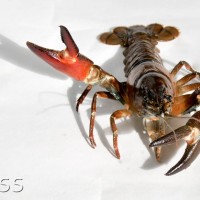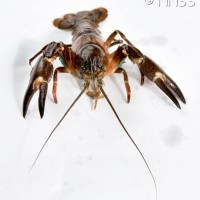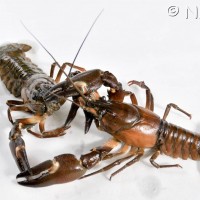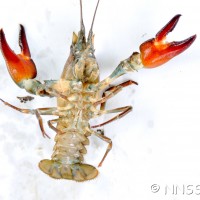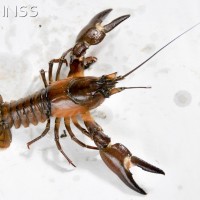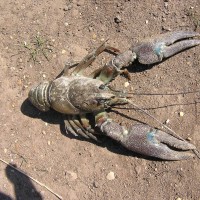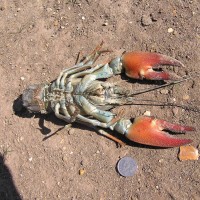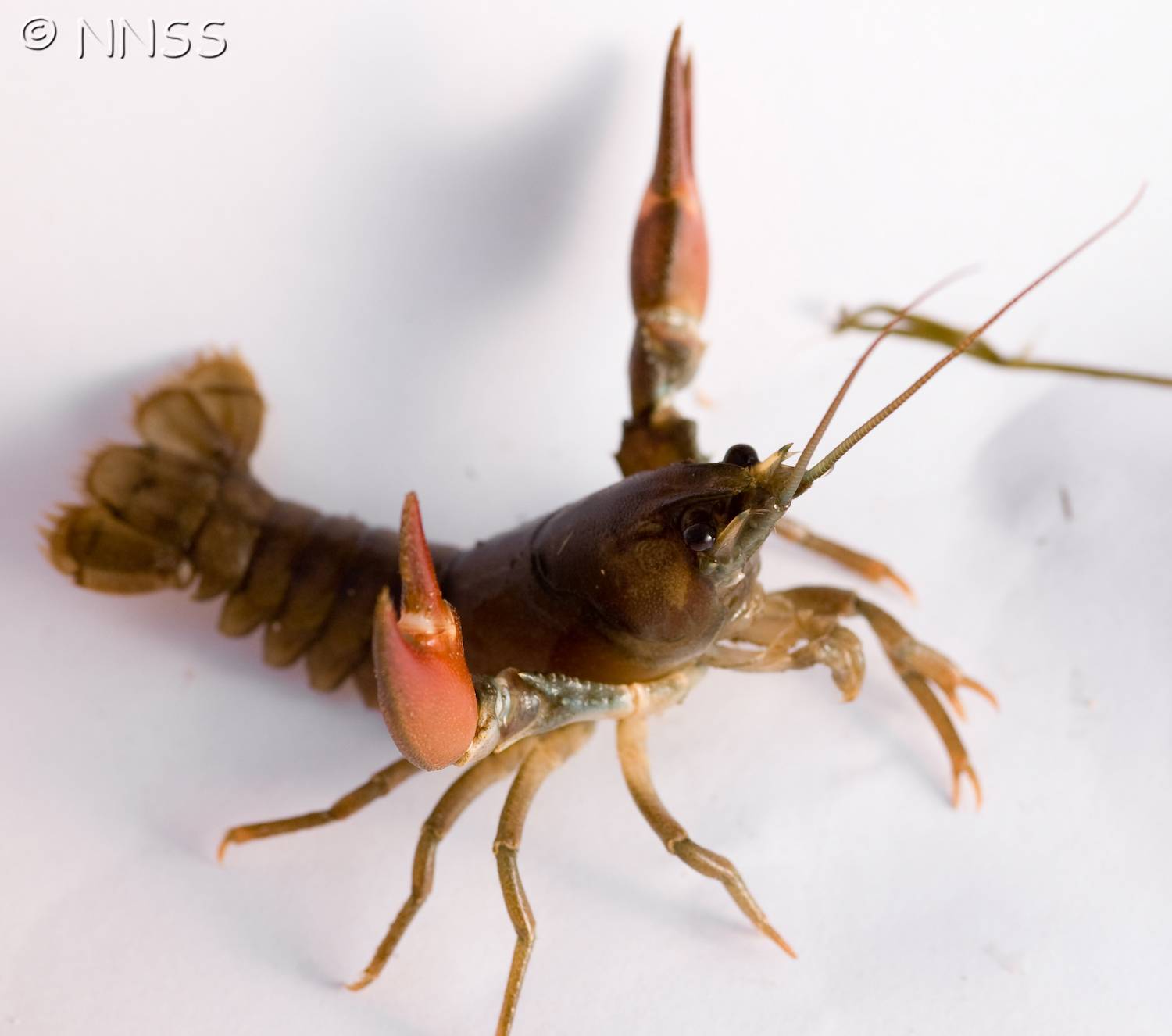
Signal Crayfish - Pacifastacus leniusculus
Expand and collapse the sections below by clicking on the title or + / - icons.
Short description of Pacifastacus leniusculus, Signal Crayfish
The signal crayfish is lobster-like in appearance and reaches a maximum size of 16-18cm. It is much larger than the native white-clawed crayfish and its claws have red undersides with a small turquoise/white blotch on the upper surface at the claw hinge.
Impact summary: Pacifastacus leniusculus, Signal Crayfish
The signal crayfish is driving the native white-clawed crayfish towards extinction and causing declines in diversity and richness of aquatic communities. Commercial fisheries have been affected by predation of fish eggs and competition between crayfish and salmonids for refuges. Burrowing by crayfish can cause erosion of riverbanks and destabilise structures built at the edges of rivers.
Habitat summary: Pacifastacus leniusculus, Signal Crayfish
Signal crayfish are found in streams, canals, rivers, lakes and ponds, and are also able to survive in brackish water.
Overview table
| Environment | Freshwater |
|---|---|
| Species status | Non-Native |
| Native range | Northern America, British Columbia |
| Functional type | Omnivore |
| Status in England | Non-Native |
| Status in Scotland | Non-Native |
| Status in Wales | Non-Native |
| Location of first record | |
| Date of first record | 1975 |
Origin
The signal crayfish is native to western North America.
First Record
First introduced in 1976, and then spread rapidly throughout the 1970s and 1980s.
Pathway and Method
The signal crayfish was introduced to be farmed for food, but escaped through water courses and across land, quickly spreading across GB.
Species Status
Signal crayfish have been introduced into over twenty countries in Europe since the 1960s. After escaping from farms in the 1970s they are now widespread across England and Wales, especially southern England. Thames, Anglian and South West water regions reported a 43% increase in occurrence between 1997 and 2001. Distribution in Scotland is limited, but populations have become established at several locations since 1995.
Dispersal Mechanisms
Signal crayfish are able to disperse up and downstream, cross most natural and artificial barriers and travel over land to reach water bodies nearby. Dispersal distances of 341m in 2 days, and several hundred metres over land in one night have been recorded. Dispersal is also aided by human transfer and release of individuals, although this is now illegal.
Reproduction
Mating takes place in autumn and females carry a dense clutch of 200-400 eggs on the underside of their tail over the winter. Once hatched, the young remain attached to the females until release in May-June. The young resemble adults and are able to feed on most animal and plant food. Signal crayfish are sexually mature at the age of 2-3 years and can live up to 20 years
Known Predators/Herbivores
Known predators include otters, mink, predatory fish such as grayling, pike, perch, Atlantic salmon, brown trout and eel.
Resistant Stages
Adults shelter in riverbank burrows in winter and enter a state of torpor.
Habitat Occupied in GB
Signal crayfish are found in streams, canals, rivers, lakes and ponds, and are also able to survive in brackish water.
Environmental Impact
Signal crayfish are driving native crayfish towards extinction through the spread of crayfish plague and competition for resources (refuges in particular). Signal crayfish grow faster, are more fecund, more aggressive and are tolerant of a wider range of conditions than the white-clawed crayfish, and therefore out-compete the native species. They feed on fish and amphibian eggs, tadpoles, juvenile fish, aquatic invertebrates, detritus and aquatic vegetation and so may reduce populations of native species and affect food webs. Signal crayfish eat more than white-clawed crayfish and have reduced the number of invertebrates and are partly blamed for amphibian declines. Community diversity and richness are lower, and food webs are altered at sites containing signal crayfish.
Health and Social Impact
None known.
Economic Impact
Crayfish burrowing can cause erosion of riverbanks. Burrows can be up to 2m deep, with many inter-connecting tunnels that weaken the bank. This can contribute to problems with flooding, livestock safety and stability of structures built on the banks. Crayfish also take refuges from salmonid fish and predate fish eggs, which could reduce the value of commercial fisheries.
Identification
www.nonnativespecies.org – Signal crayfish factsheet produced by Olaf Booy, Max Wade and Vicky White
Biology, ecology, spread, vectors
Axelsson, E., Nystrom, P., Sidenmark, J. & Bronmark, C. (1997) Crayfish predation on amphibian eggs and larvae. Amphibia-Reptilia, 18, 217-228.
Bubb, D.H., Thom, T.J. & Lucas, M.C. (2006) Movement, dispersal and refuge use of co-occurring introduced and native crayfish. Freshwater Biology, 51, 1359-1368.
Guan, R.Z. & Wiles, P.R. (1998) Feeding ecology of the signal crayfish Pacifastacus leniusculus in a British lowland river. Aquaculture, 169, 177-193.
Guan, R.Z. & Wiles, P.R. (1999) Growth and reproduction of the introduced crayfish Pacifastacus leniusculus in a British lowland river. Fisheries Research, 42, 245-259.
Holdich, D.M. (1993) A review of astaciculture: freshwater crayfish farming. Aquatic Living Resources, 6, 307-317.
Management and impact
Crawford, L., Yeomans, W.E. & Adams, C.E. (2006) The impact of introduced signal crayfish Pacifastacus leniusculus on stream invertebrate communities. Aquatic Conservation: Marine and freshwater ecosystems, 16, 611-621.
Freeman, M.A., Turnbull, J.F., Yeomans, W.E. & Bean, C.W. (2010) Prospects for management strategies of invasive crayfish populations with an emphasis on biological control. Aquatic Conservation: Marine and freshwater ecosystems, 20, 211-223.
Peay, S., Hiley, P.D., Collen, P. & Martin I. (2006) Biocide treatment of ponds in Scotland to eradicate signal crayfish. Bull. Fr. Peche Piscic., 380-381, 1363-1379.
General
Holdich, D. M. & Sibley, P. J. (eds) (2003) Management & Conservation of Crayfish. Proceedings of a conference held on 7th November, 2002. Environment Agency, Bristol. 217 pp.
Sibley, P.J., Brickland, J.H. & Bywater, J.A. (2002) Monitoring the distribution of crayfish in England and Wales. Bull. Fr. Peche Piscic., 367, 833-844.
www.ribbletrust.org.uk
https://www.cabi.org/isc/datasheet/70581
https://secure.fera.defra.gov.uk/nonnativespecies/downloadDocument.cfm?id=54
Spotted this species?
Distribution map
View the Distribution map for Signal Crayfish, Pacifastacus leniusculus from NBN Atlas
Risk assessment
Risk assessment for Pacifastacus leniusculus. See a full list of non-native species Risk assessments.
Management
Links to management practices for Pacifastacus leniusculus. See all management information.
Legislation
This species is a Species of Special Concern. Find out more about non-native species legislation.

